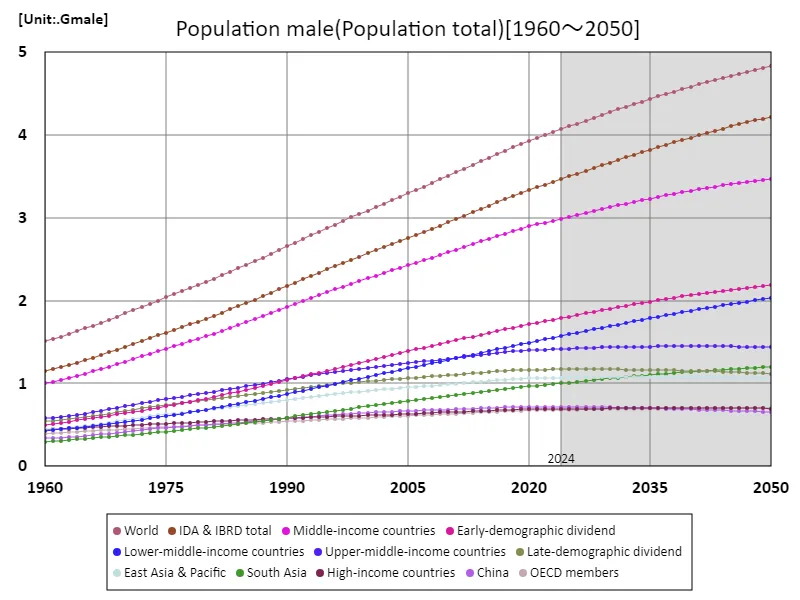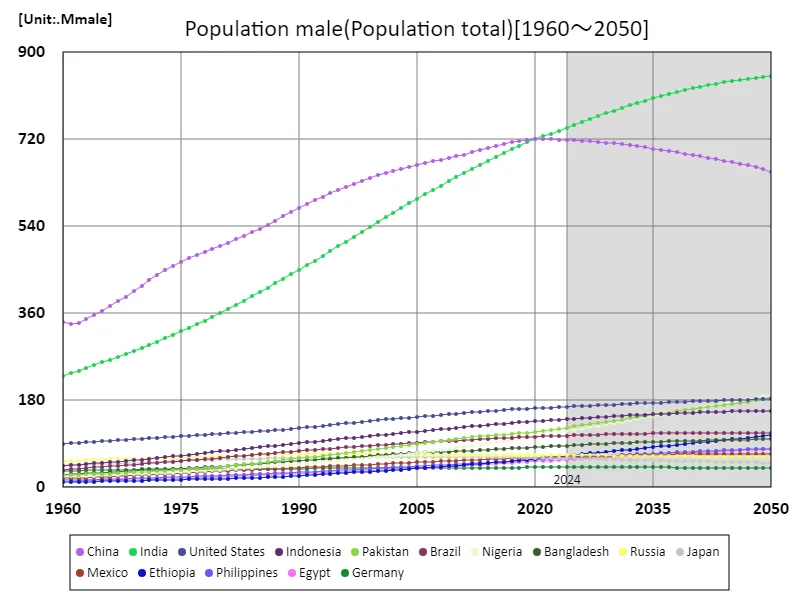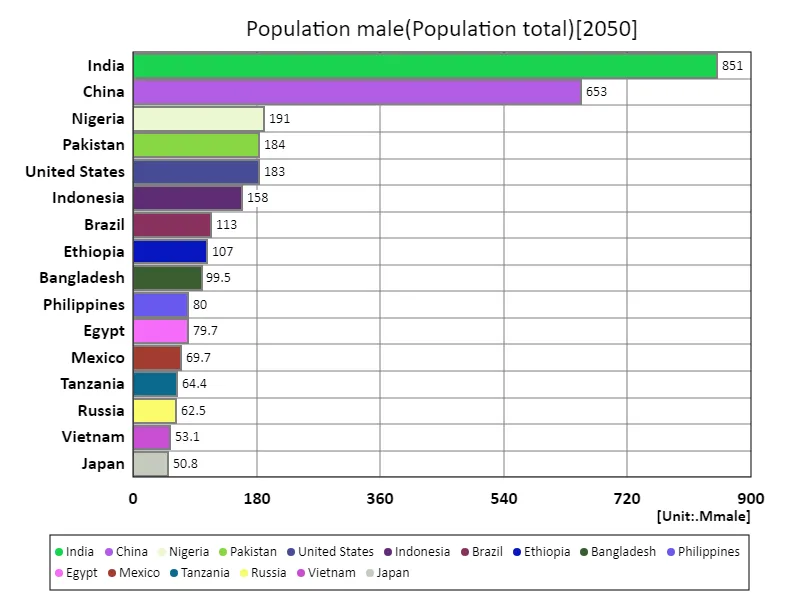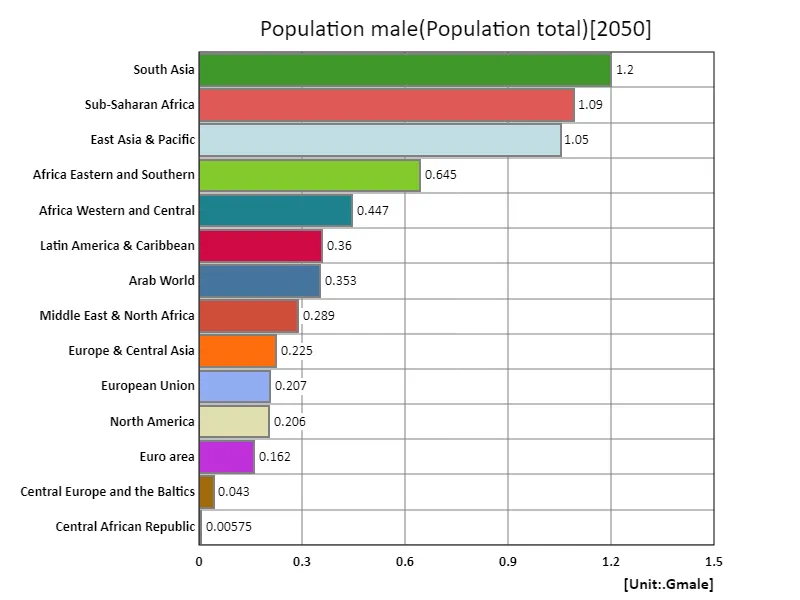Abstract
The projection that the world’s male population will reach 4.83 billion in 2050 reflects several important economic and social trends. First, there is the overall population growth and fluctuations in birth rates. Many countries, especially developing countries, continue to have high birth rates, which is driving an increase in the male population. Meanwhile, in developed countries, although birth rates are declining, populations are aging due to longer life spans. In these areas, the male population is growing more slowly, but the overall population is growing. Economic factors also play a major role. In countries experiencing rapid economic growth, urbanization is progressing and demographic changes are occurring. The young male population in particular is likely to grow, which means increased demands on the labour market, education system and social services. Furthermore, increasing international migration is also affecting the distribution of the male population. These changes pose major challenges to labour markets and social security systems, while urging policymakers to adapt.
Male population
When considering male population trends between 1960 and 2050, several important characteristics emerge. In 1960, the world’s male population was approximately 2 billion, but is projected to reach 4.83 billion by 2050. This reflects the rapid growth in the overall population, driven in particular by high birth rates in developing countries. From the 1960s to the 1990s, male population growth occurred primarily in conjunction with high birth rates. However, since the 2000s, declining birth rates and aging populations have become prominent in developed countries, causing a relative slowdown in the growth of the male population. Meanwhile, birth rates remain high in developing countries and the male population is growing rapidly. This is the main factor shaping the peak of the world’s male population in 2050. The effects of urbanization and migration also cannot be overlooked. Increasing urbanization is driving the concentration of young men in urban areas, resulting in demographic changes across regions. Population movements due to migration also contribute to the increase in the male population in certain areas. These changes will have significant implications for labor markets and social systems and will be important considerations in future policy design.


The maximum is the latest one, 4.83Gmale of World
Male population (worldwide)
If we look at the male population data from 1960 to 2050, we can see that India’s male population has witnessed a remarkable growth. In 1960, India’s male population was around 200 million, but is projected to reach 851 million by 2050. This indicates that India is one of the fastest growing countries in the world. This increase is mainly due to high birth rates and rapid population growth. Since the 1960s, India’s birth rates have been high, driven by larger family units, especially in rural areas. However, birth rates have been gradually declining in recent years, and the rate of increase may slow in the coming decades. Nevertheless, historically high fertility rates and a broad population base have supported a large increase in the male population. India’s rapid growth is also linked to economic factors. As the country experiences rapid urbanization and economic development, the young male population is particularly increasing, with a significant impact on the labor market. Migration to urban areas and increased economic opportunities are driving a rise in the proportion of young men, changing social dynamics. India’s growing male population will pose new challenges and opportunities for the labour market, social policies and infrastructure development in the future. This calls for policymakers to respond strategically to ensure sustainable growth and social stability.


The maximum is the latest one, 851Mmale of India
Male population (worldwide, latest year)
According to data for 2050, the world’s male population is expected to reach 4.65 billion, of which India will account for the largest proportion at 851 million. This reflects India’s rapid growth on a global scale, particularly as the country enjoys a high birth rate. While India’s male population makes up the majority of the total, the average is 23.9 million, showing significant population differences between countries. Looking back at trends since 1960, the increase in the male population has been mostly noticeable in developing countries. Countries with high fertility rates like India are experiencing rapid growth and the young male population is increasing amid urbanization and economic development. Meanwhile, in developed countries, birth rates are declining and populations are aging, meaning the male population is growing relatively slowly. This has led to large regional differences in the distribution of the male population worldwide. High fertility rates in countries such as India have significant implications for economic development and labour market changes, raising new challenges for social policies and infrastructure development. Conversely, developed countries are facing problems such as ageing populations and labour shortages, which require different responses. Overall, demographic change will have a major impact on each country’s economy and society, requiring strategic responses from a global perspective.


The maximum is 851Mmale of India, the average is 23.9Mmale, and the total is 4.6Gmale
Male population (region, latest year)
According to data for 2050, the world’s male population will be 6.29 billion, of which South Asia will account for the largest proportion of 1.2 billion. This situation is indicative of rapid population growth in South Asia, particularly in India, driven by high birth rates and a large population base. The increase in South Asia’s male population reflects economic and social changes in the region, which, due to the large youth population, also have significant implications for the labour market and education systems. The trend since 1960 has been that the increase in the male population has been mostly noticeable in developing countries. In regions like South Asia, fertility rates remain high, supporting rapid growth. Meanwhile, in developed countries, birth rates are declining and the population is aging, so the increase in the male population is relatively slow. This has led to significant differences in the distribution of male population across regions. The average male population is 419 million, which, when compared to the figures for South Asia, highlights the difference in population size with other regions. The increase in the male population brings about economic and social challenges that vary from region to region, and requires policy responses on multiple fronts, including in terms of labor supply, social security, and infrastructure development. Overall, demographic change will have significant impacts on global economies and societies, calling for strategic responses.


The maximum is 1.2Gmale of South Asia, the average is 419Mmale, and the total is 6.29Gmale



Comments